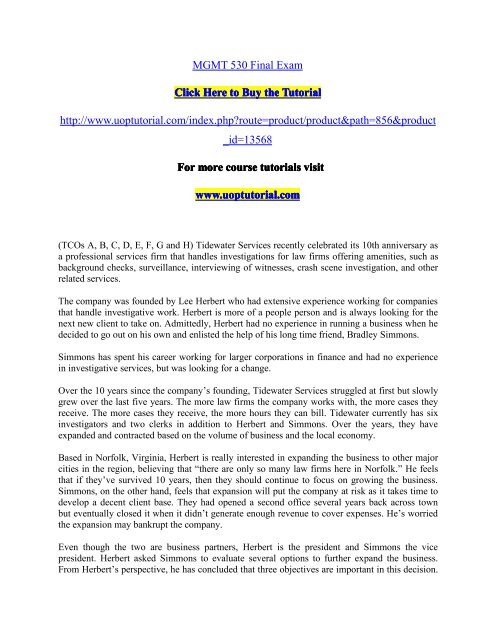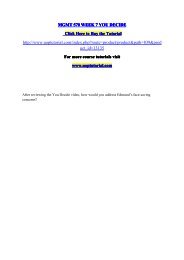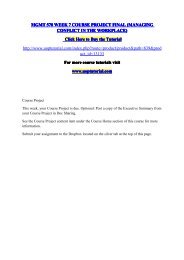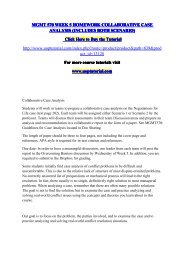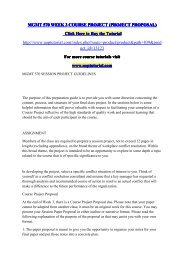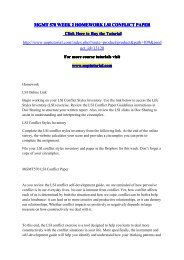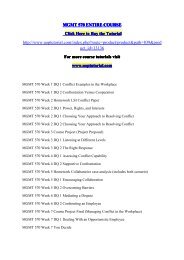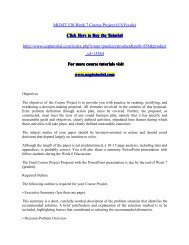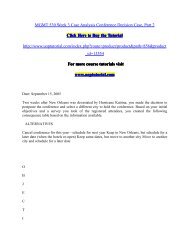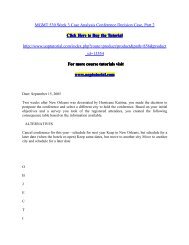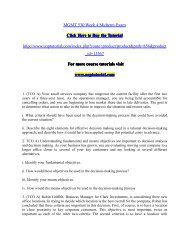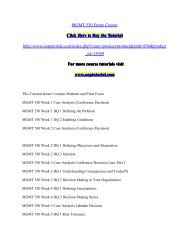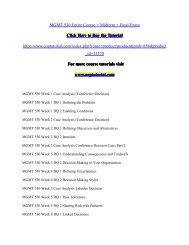MGMT 530 Final Exam
- No tags were found...
Create successful ePaper yourself
Turn your PDF publications into a flip-book with our unique Google optimized e-Paper software.
<strong>MGMT</strong> <strong>530</strong> <strong>Final</strong> <strong>Exam</strong><br />
Click Here to Buy the Tutorial<br />
http://www.uoptutorial.com/index.php?route=product/product&path=856&product<br />
_id=13568<br />
For more course tutorials visit<br />
www.uoptutorial.com<br />
(TCOs A, B, C, D, E, F, G and H) Tidewater Services recently celebrated its 10th anniversary as<br />
a professional services firm that handles investigations for law firms offering amenities, such as<br />
background checks, surveillance, interviewing of witnesses, crash scene investigation, and other<br />
related services.<br />
The company was founded by Lee Herbert who had extensive experience working for companies<br />
that handle investigative work. Herbert is more of a people person and is always looking for the<br />
next new client to take on. Admittedly, Herbert had no experience in running a business when he<br />
decided to go out on his own and enlisted the help of his long time friend, Bradley Simmons.<br />
Simmons has spent his career working for larger corporations in finance and had no experience<br />
in investigative services, but was looking for a change.<br />
Over the 10 years since the company’s founding, Tidewater Services struggled at first but slowly<br />
grew over the last five years. The more law firms the company works with, the more cases they<br />
receive. The more cases they receive, the more hours they can bill. Tidewater currently has six<br />
investigators and two clerks in addition to Herbert and Simmons. Over the years, they have<br />
expanded and contracted based on the volume of business and the local economy.<br />
Based in Norfolk, Virginia, Herbert is really interested in expanding the business to other major<br />
cities in the region, believing that “there are only so many law firms here in Norfolk.” He feels<br />
that if they’ve survived 10 years, then they should continue to focus on growing the business.<br />
Simmons, on the other hand, feels that expansion will put the company at risk as it takes time to<br />
develop a decent client base. They had opened a second office several years back across town<br />
but eventually closed it when it didn’t generate enough revenue to cover expenses. He’s worried<br />
the expansion may bankrupt the company.<br />
Even though the two are business partners, Herbert is the president and Simmons the vice<br />
president. Herbert asked Simmons to evaluate several options to further expand the business.<br />
From Herbert’s perspective, he has concluded that three objectives are important in this decision.
First, is to find a city with a large number of Fortune 500 companies, a cost of living comparable<br />
to Norfolk, and a city that is in a reasonable distance from Norfolk as he and Simmons would be<br />
spending a lot of time in the new office at first. Because both have families with young children,<br />
Herbert feels that the distance is twice as important as the other criteria.<br />
Here is the summary of Simmons’ research.<br />
I. Richmond, Virginia: Number of Fortune 500 Companies: 5; Cost of Living Comparison: 0.934<br />
(less than Norfolk); Driving Distance: 81 miles<br />
II. Charlotte, North Carolina: Number of Fortune 500 Companies: 7; Cost of Living Comparison:<br />
0.834 (less than Norfolk); Driving Distance: 283 miles<br />
III. Atlanta, Georgia: Number of Fortune 500 Companies: 10; Cost of Living Comparison: 0.854<br />
(less than Norfolk); Driving Distance: 503 miles<br />
Question 1. Define the decision problem and the general nature of the problem. (20 Points)<br />
Question 2. What event triggered<br />
Question 3. Are we imposing any implied constraints on the situation<br />
Question 4. Define the objectives<br />
Question 5. Identify the alternatives<br />
Question 6. Compare and contrast the consequences for all three alternatives by the fundamental<br />
objectives. Rank each alternative using proportional scoring, include weights on the objectives.<br />
Are there any dominated alternatives that can be eliminated? Are there any even swaps.<br />
Question 7. What decision-making styles are at work here? What is their attitude towards risk?
Question 8. Are there any biases in play here that may impact the effectiveness of the decision?<br />
Question 9. What are the uncertainties for this decision situation? What are their consequences?<br />
Question 10. Evaluate this decision situation using tradeoffs. What location should they select?<br />
Are there any linked decisions? Discuss any assumptions as needed.


